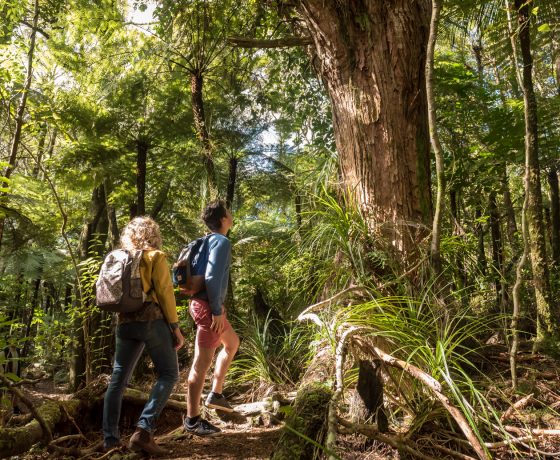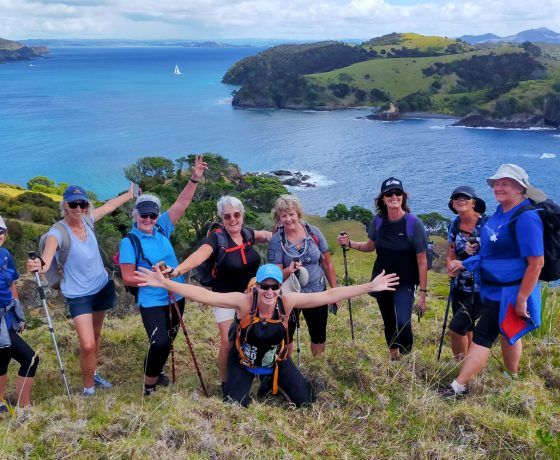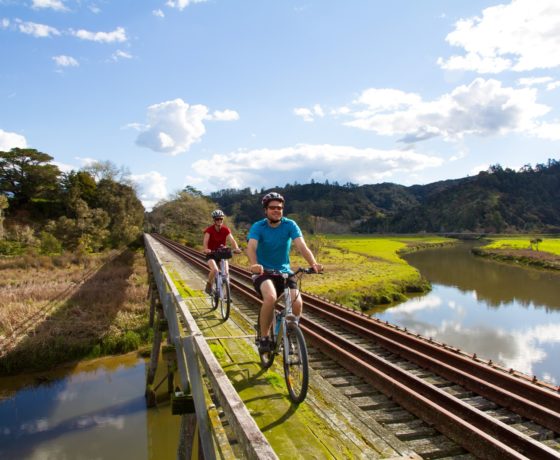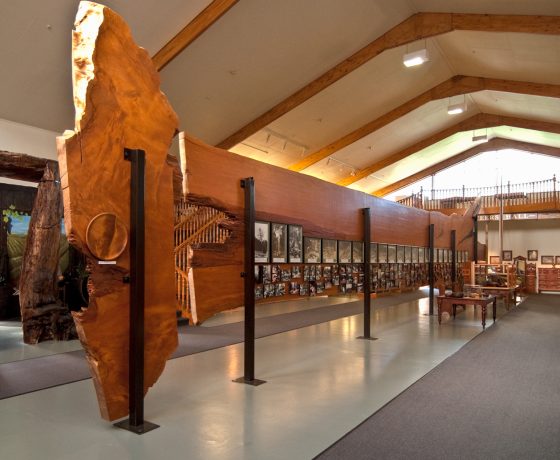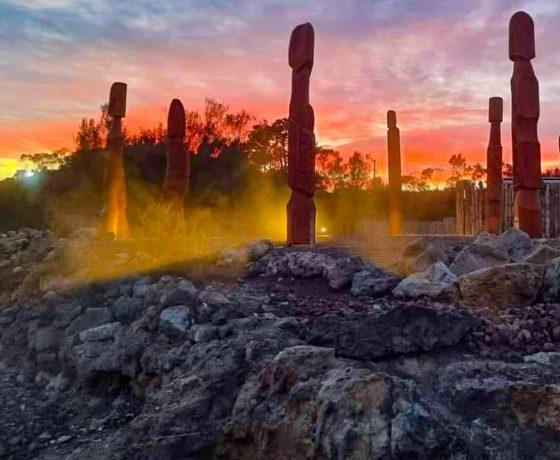Things To Do – Kauri Coast & Hokianga
Top Things to See & Do – Hokianga & the Kauri Coast, Northland
Northland’s West Coast Wonder

Hokianga & The Kauri Coast – Twin Coast Discovery Highway
From the Brynderwyns in the south to Hokianga in the north, this region offers so many things to do for the visitor. The Kauri Coast is home to the world’s oldest and largest ancient kauri trees, New Zealand’s longest beach stretching some 112 km, and New Zealand’s largest harbour, the Kaipara. Just inland from the coast, the Kai Iwi Lakes — a trio of stunning freshwater dune lakes — provide a perfect spot for swimming, kayaking, and picnicking, with some of the clearest, bluest waters in the country.
To the north is the Hokianga, a deep harbour fringed by the seaside villages of Omapere and Opononi on one side, and the towering Hokianga sand dunes on the other.
Heading north from Auckland, it is recommended to take the turnoff at the Brynderwyns and follow the Northland Twin Coast Discovery Highway in a clockwise direction — a scenic circular tourist route around Northland that enables you to experience the Kauri Coast on the west coast, and the Bay of Islands and Whangarei on the east. These two stunning coastlines collide at the spiritual Cape Reinga, where the Tasman Sea and the Pacific Ocean meet in a dramatic swirl of currents.
Matakohe – Kauri Museum (Must-Visit)
Your first essential stop is the Kauri Museum in Matakohe — a world-class showcase of New Zealand’s pioneering days and the kauri gum era. Explore massive tree cross-sections, historic machinery, early photographs, and interactive exhibits that bring the Kauri Coast’s legacy to life.
Dargaville – River Town & Kumara Capital
Nestled on the banks of the Northern Wairoa River, Dargaville is the largest town along the Kauri Coast. Known as New Zealand’s Kumara Capital, it offers a taste of rural charm and classic Kiwi hospitality. Visit the Kumara Box attraction for a light-hearted tour with local personality Ernie, who’ll take you behind the scenes of Northland’s sweetest crop.
Pouto – Lighthouse & Remote Beach Access
At the entrance of the vast Kaipara Harbour, the remote coastal settlement of Pouto is known for its shipwreck stories, sandy trails, and the historic Pouto Lighthouse. Adventurers can drive the scenic gravel route from Dargaville and explore the dunes and shoreline on foot. Though remote, the area rewards travellers with panoramic harbour views and a deep sense of isolation.
Baylys Beach – Ripiro Adventures
Just 14km from Dargaville lies Baylys Beach, gateway to Ripiro Beach — New Zealand’s longest drivable beach. This peaceful seaside village is popular for surfcasting, sunsets, and off-road adventure. Local operators offer quad bike rentals and horse trekking, making it a perfect base for both relaxation and action.
Waipoua Forest – Home of Tane Mahuta
As you travel north, the road winds through the Waipoua Forest, one of the last remaining strongholds of New Zealand’s ancient kauri forests. This is where you’ll find Tane Mahuta, the legendary “God of the Forest” — the largest living kauri tree in the world, estimated to be over 2,000 years old.
Short, well-maintained walking tracks lead from the roadside to several towering trees including Te Matua Ngahere (the Father of the Forest) and Four Sisters, a group of intertwined kauri trunks. Interpretive signs along the forest paths offer insight into the natural and spiritual significance of the trees in Maori cosmology.
Visit during the late afternoon or early evening and you may find fewer visitors, softer light, and a more serene connection with the forest.
Opononi & Omapere – Hokianga’s Twin Harbour Towns
Emerging from the forest, you’ll reach the calm, sweeping harbour of Hokianga, framed by the seaside villages of Opononi and Omapere. These twin towns offer magnificent sunset views, local cafés, and a slower pace that feels a world away from city life.
The harbour was once made famous by Opo the dolphin, a wild bottlenose dolphin who became a local legend in the 1950s for playing with children in the shallows. A statue in Opononi commemorates her memory.
Across the harbour, you’ll see the towering Hokianga sand dunes — accessible by water taxi from the jetty. Bring a board and try sandboarding, or just hike to the top for sweeping views over the harbour and Tasman Sea.
Manea – Footprints of Kupe
For a truly special cultural experience, visit Manea: Footprints of Kupe, located in Opononi. This world-class M?ori cultural centre celebrates the story of Kupe, the great Polynesian navigator believed to have first discovered Aotearoa.
Through storytelling, digital displays, carving, and immersive theatre, you’ll be guided on a spiritual journey that connects the past, present, and future of this sacred region. It’s more than just a visitor attraction — it’s a profound connection to M?ori history and whakapapa.
Rawene & the Hokianga Ferry
At the inner edge of the harbour, Rawene is one of New Zealand’s oldest European settlements. Wander its historic streets, visit the beautifully preserved Clendon House, and stop at the artsy cafés and shops that line the waterfront. From here, take the Rawene–Kohukohu vehicle ferry across the harbour — a short but scenic ride that connects the western and eastern sides of the Hokianga and forms part of the Twin Coast Discovery loop.
Things to do in the Hokianga & the Kauri Coast

Free Things to Do in the Kauri Coast & Hokianga
Northland’s wild west coast is a place of raw beauty, cultural depth, and quiet adventure — and some of its best experiences are completely free. From towering kauri forests and glassy dune lakes to fishing spots, coastal walks, and harbour sunsets, here are the top no-cost things to do in the Kauri Coast and Hokianga region.
Travelling with kids or planning a laid-back family getaway? Many of the best free things to do in the Kauri Coast and Hokianga are also perfect for families. Whether you’re heading out for a bushwalk, paddling in freshwater lakes, or exploring coastal villages, there’s something here for everyone — without spending a cent.
Visit Tane Mahuta in Waipoua Forest
No trip to the Kauri Coast is complete without meeting T?ne Mahuta, the largest living kauri tree in the world. Located in Waipoua Forest, this awe-inspiring giant is just a short walk from the main highway and surrounded by interpretive signs explaining its ecological and spiritual importance. Entry is free, and the site is accessible year-round.
Explore Longer Kauri Walks – Te Matua Ngahere & Four Sisters
Beyond Tane Mahuta, Waipoua Forest offers longer trails leading to other iconic trees. Walk deeper into the bush to visit Te Matua Ngahere (“Father of the Forest”), believed to be more than 2,500 years old, and the elegant Four Sisters, a cluster of tall, closely grouped kauri. These trails are free to access and well signposted from the roadside.
Swim, Kayak or Picnic at Kai Iwi Lakes
Located inland from Dargaville, the Kai Iwi Lakes (Taharoa Domain) are renowned for their turquoise waters and white sandy shores. Ideal for swimming, kayaking, and picnicking, the lakes are family-friendly and free to access. Walking trails surround the lakes, and there are grassy spots to relax and take in the view.
Walk the Trounson Kauri Park Loop
This peaceful, predator-controlled reserve is home to mature kauri trees, native ferns, and birdsong. The short loop track takes you through beautiful regenerating forest and is suitable for all ages. Entrance to Trounson Kauri Park is free, and it’s a great alternative to busier Waipoua Forest.
Walk to the Hokianga Heads – Arai te Uru Nature Reserve – Stunning Coastal Lookouts
Situated at the southern head of the Hokianga Harbour near Omapere, this scenic reserve offers dramatic views over the harbour entrance and Tasman Sea. Walk to the viewpoint near the signal station for panoramic coastal vistas, and take the short loop track through native bush.
The site is culturally significant to local Māori and is a perfect free stop to take in the raw beauty of the west coast.For a scenic and peaceful experience, take the walking trail from Omapere around the coastline toward the Hokianga Heads. The trail offers stunning views over the harbour, rolling dunes across the water, and crashing waves where the harbour mouth meets the Tasman Sea. It’s especially beautiful around sunset.
Sandboard the Giant Hokianga Dunes
Across the harbour from Opononi lie the massive golden dunes that define the Hokianga landscape. Accessible by water taxi from the Opononi jetty, the dunes are free to explore. Bring a bodyboard for sandboarding or simply hike to the top for sweeping views.
Cast a Line from a Wharf or Beach
Whether you’re at Rawene, Opononi, or Baylys Beach, fishing is a great way to connect with the locals and the landscape. No license is required for saltwater fishing in New Zealand, and catching kahawai or snapper straight from the wharf or surf is a classic Kiwi experience.
Koutu Boulders – Northland’s Giant Natural Sphere
Located near the small settlement of Koutu, these mysterious round boulders are scattered along the beach, some as large as 3 metres in diameter. Best seen at low tide, the Koutu Boulders are a fascinating geological feature formed over millions of years. They’re free to visit and easily accessed via a short coastal track or beach walk from Waione Road. A hidden gem for curious explorers and photographers.
Explore Rawene’s Historic Waterfront
Rawene is one of the oldest European settlements in the country, with heritage buildings and a quiet, arty vibe. Walk the historic streets, browse galleries and local crafts, and enjoy the harbour views from the boardwalk — all at no cost.
Watch the Sunset from Signal Station Lookout or Omapere
The Hokianga Harbour is famous for its fiery sunsets, best viewed from Omapere Beach or the elevated Signal Station Lookout. Both spots offer breathtaking panoramas as the sun dips behind the dunes and lights up the harbour — no ticket required.
Plan Your Visit to the Kauri Coast & Hokianga
Whether you’re exploring ancient forests, cooling off in freshwater lakes, or simply watching the sun sink into the Tasman Sea, the Kauri Coast and Hokianga region proves that some of New Zealand’s best experiences don’t cost a thing. With so many free and memorable activities on offer, it’s the perfect destination for travellers seeking natural beauty, cultural depth, and genuine Northland charm — all without breaking the bank.


